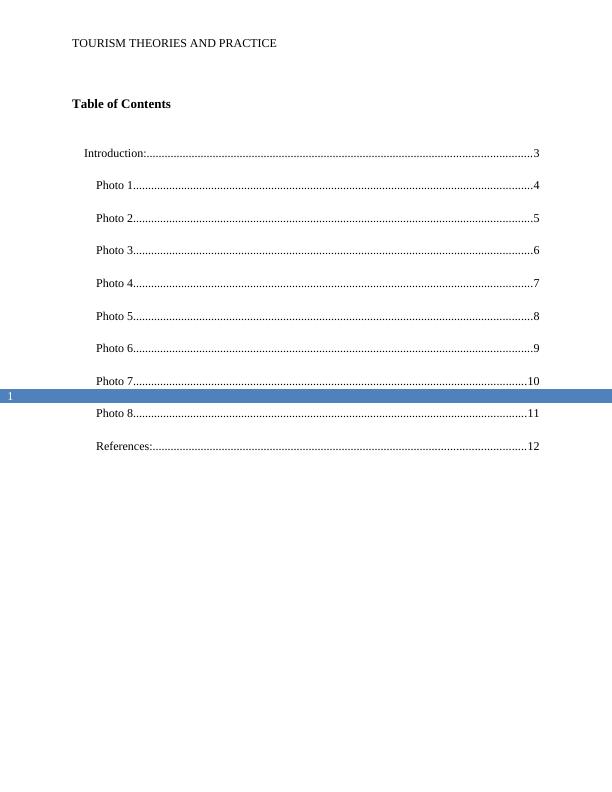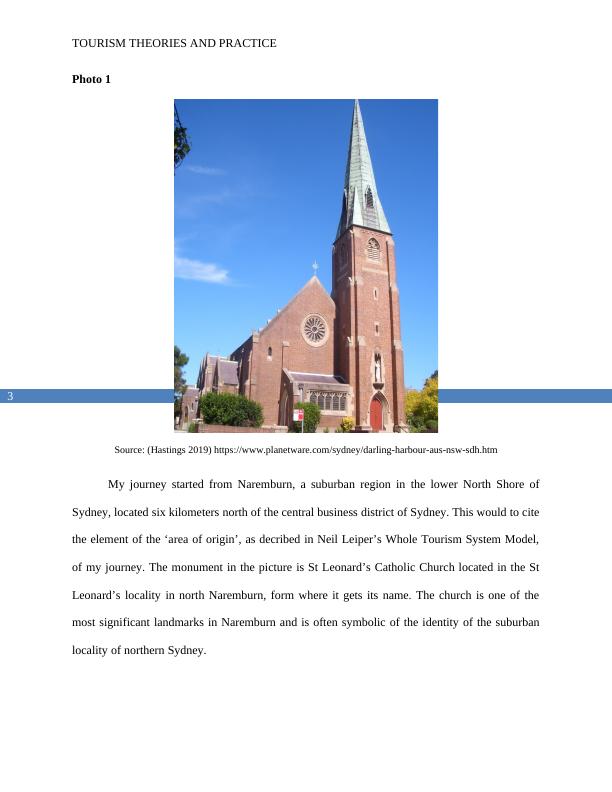Tourism Theories and Practices
Added on 2022-12-29
13 Pages1874 Words2 Views
Running Head: TOURISM THEORIES AND PRACTICE
Tourism Theories and Practices
Name of Student:
Name of University:
Author’s Note:
Tourism Theories and Practices
Name of Student:
Name of University:
Author’s Note:

1
TOURISM THEORIES AND PRACTICE
Table of Contents
Introduction:................................................................................................................................3
Photo 1.....................................................................................................................................4
Photo 2.....................................................................................................................................5
Photo 3.....................................................................................................................................6
Photo 4.....................................................................................................................................7
Photo 5.....................................................................................................................................8
Photo 6.....................................................................................................................................9
Photo 7...................................................................................................................................10
Photo 8...................................................................................................................................11
References:............................................................................................................................12
TOURISM THEORIES AND PRACTICE
Table of Contents
Introduction:................................................................................................................................3
Photo 1.....................................................................................................................................4
Photo 2.....................................................................................................................................5
Photo 3.....................................................................................................................................6
Photo 4.....................................................................................................................................7
Photo 5.....................................................................................................................................8
Photo 6.....................................................................................................................................9
Photo 7...................................................................................................................................10
Photo 8...................................................................................................................................11
References:............................................................................................................................12

2
TOURISM THEORIES AND PRACTICE
Introduction:
Neil Leiper, a leading academic tourism scholar from Australia created a model of tourism
attraction systems in 1990, which came to be known as Leiper’s Whole Tourism System.
Through this system, Leiper established his concept and perception of tourism and issues, he felt
were attached with its management. The elements that he included in his model system are
tourists, generating regions, transit routes, destination regions and a tourist industry (Lamont
2009) (such as travel or hospitality). These elements are interconnected with a number of spatial
and temporal factors such as culture, economy, politics, environment and technology (Hall and
Page 2017). Leiper, through his approach tried to understand origin areas, transit regions,
destinations and their environments and flows as parts of a single, more comprehensive tourism
system instead of analyzing them as separate independent entities.
The main objective of Leiper’s Whole Tourism System model was to suggest a
framework in which people, places and organisations interact in certain ways through the course
of a tourism expedition. He opined that there are certain ‘push’ and ‘pull’ factors that encourage
people to engage in tourism. The pull defines the attractions tourists find towards the destination,
while the push refers to the factors that cause the tourists to leave their place of origin or
generation (UKEssays 2018). Through his works, Leiper established that attractions are the
various sights, events and facilities created for enhancing the experiences of tourists. This report
will look at a local, photographed tourism experience at Sydney’s Darling Harbour, along with a
transit stopover at Sydney Harbor Bridge.
TOURISM THEORIES AND PRACTICE
Introduction:
Neil Leiper, a leading academic tourism scholar from Australia created a model of tourism
attraction systems in 1990, which came to be known as Leiper’s Whole Tourism System.
Through this system, Leiper established his concept and perception of tourism and issues, he felt
were attached with its management. The elements that he included in his model system are
tourists, generating regions, transit routes, destination regions and a tourist industry (Lamont
2009) (such as travel or hospitality). These elements are interconnected with a number of spatial
and temporal factors such as culture, economy, politics, environment and technology (Hall and
Page 2017). Leiper, through his approach tried to understand origin areas, transit regions,
destinations and their environments and flows as parts of a single, more comprehensive tourism
system instead of analyzing them as separate independent entities.
The main objective of Leiper’s Whole Tourism System model was to suggest a
framework in which people, places and organisations interact in certain ways through the course
of a tourism expedition. He opined that there are certain ‘push’ and ‘pull’ factors that encourage
people to engage in tourism. The pull defines the attractions tourists find towards the destination,
while the push refers to the factors that cause the tourists to leave their place of origin or
generation (UKEssays 2018). Through his works, Leiper established that attractions are the
various sights, events and facilities created for enhancing the experiences of tourists. This report
will look at a local, photographed tourism experience at Sydney’s Darling Harbour, along with a
transit stopover at Sydney Harbor Bridge.

3
TOURISM THEORIES AND PRACTICE
Photo 1
Source: (Hastings 2019) https://www.planetware.com/sydney/darling-harbour-aus-nsw-sdh.htm
My journey started from Naremburn, a suburban region in the lower North Shore of
Sydney, located six kilometers north of the central business district of Sydney. This would to cite
the element of the ‘area of origin’, as decribed in Neil Leiper’s Whole Tourism System Model,
of my journey. The monument in the picture is St Leonard’s Catholic Church located in the St
Leonard’s locality in north Naremburn, form where it gets its name. The church is one of the
most significant landmarks in Naremburn and is often symbolic of the identity of the suburban
locality of northern Sydney.
TOURISM THEORIES AND PRACTICE
Photo 1
Source: (Hastings 2019) https://www.planetware.com/sydney/darling-harbour-aus-nsw-sdh.htm
My journey started from Naremburn, a suburban region in the lower North Shore of
Sydney, located six kilometers north of the central business district of Sydney. This would to cite
the element of the ‘area of origin’, as decribed in Neil Leiper’s Whole Tourism System Model,
of my journey. The monument in the picture is St Leonard’s Catholic Church located in the St
Leonard’s locality in north Naremburn, form where it gets its name. The church is one of the
most significant landmarks in Naremburn and is often symbolic of the identity of the suburban
locality of northern Sydney.

End of preview
Want to access all the pages? Upload your documents or become a member.
